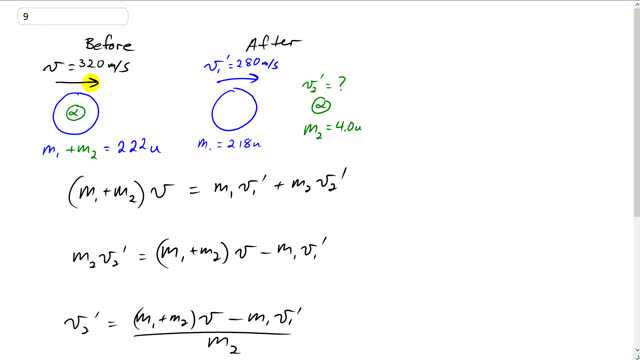
An atomic nucleus initially moving at 320 m/s emits an alpha particle in the direction of its velocity, and the remaining nucleus slows to 280 m/s. If the alpha particle has a mass of 4.0 u and the original nucleus has a mass of 222 u, what speed does the alpha particle have when it is emitted?

In order to watch this solution you need to have a subscription.
This is Giancoli Answers with Mr. Dychko. Initially, the nucleus and the α particle are combined into one nucleus of mass 222 atomic mass units, u and this combination is moving with a speed of 320 meters per second— this is before they break apart. And then the α particle is emitted; it has a mass of 4 atomic mass units leaving 218 atomic mass units left behind in this what remains in the nucleus so that's 222 minus 4 makes 218 there and this big nucleus slows it to 280 meters per second and so it loses some of its momentum and all the momentum that it lost must have been gained by this particle because total momentum of the system is conserved. So here's a mathematical way of saying total momentum is conserved; this left-hand side of the equation is before the radioactive decay and so we have total momentum is the mass of the single particle, m 1 plus m 2, times its velocity and then after the α-decay we have two separate particles; this mass m 1 times its velocity v 1 prime— 280 meters per second— and then this α particle mass times its velocity, which we have to find, v 2 prime. So let's find it by moving this term to the left side and then switching the sides around and we have m 2v 2 prime is m 1 plus m 2 times v minus m 1v 1 prime and then we'll divide both sides by m 2 and then we get that v 2 prime is the original mass of the nucleus before the alpha particle is emitted times its velocity that it's going minus the mass of the nucleus that's leftover—218— times the velocity after the α particle decay—280— and divide all that by 4 atomic mass units— mass of the α particle and this works out to 2500 meters per second must be the velocity of the alpha particle.